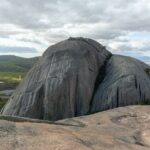Embark on a remarkable journey of geographical exploration as we unveil the breathtaking elevation of Kansas. In this captivating article, we delve into the lesser-known wonders of this enchanting region, immersing readers in its awe-inspiring natural beauty. Prepare to be amazed as we traverse the topographical features, elevation patterns, and geological formations that make Kansas a true gem for adventurers and nature enthusiasts. So, fasten your seatbelts and get ready to experience the unparalleled charm of Kansas in all its splendor.

Key Takeaways:
- Kansas has an average elevation of 1,972 feet, with a minimum elevation of 492 feet and a maximum elevation of 4,272 feet.
- Mount Sunflower is the highest point in Kansas, standing at 4,039 feet. It is located near the Colorado border in western Kansas.
- The Verdigris River is the lowest point in Kansas, situated at an elevation of 679 feet above sea level.
- The elevation in Kansas gradually increases from east to west, with rolling plains that rise in elevation.
- Climate variations in Kansas are influenced by elevation, with temperature and precipitation differences across the state.
- Kansas experiences hot summers and cold winters, with cooler temperatures at higher elevations.
- Higher elevations in Kansas often receive more precipitation compared to lower-lying areas.
- Elevation can have both positive and negative impacts on health. Mount Sunflower offers opportunities for outdoor activities and exercise, promoting physical fitness and well-being. However, individuals not acclimated to high elevations may experience altitude sickness.
- Mount Sunflower is the highest natural elevation in Kansas, despite not being an actual mountain.
- The diverse range of elevations in Kansas contributes to differences in climate and geography.
Elevation of Kansas
Kansas, with its sprawling plains and diverse topography, offers a captivating range of elevations for exploration and discovery. From the rolling hills of the eastern part of the state to the majestic peaks in the west, Kansas showcases the beauty and uniqueness of its elevation. In this article, we will delve into the fascinating world of the elevation of Kansas, unraveling its impact on geography, climate, and even human health.
The Varying Elevations of Kansas
Kansas boasts an average elevation of 1,972 feet, with a minimum elevation of 492 feet and a maximum elevation of 4,272 feet. The state’s highest natural elevation is Mount Sunflower, standing tall at 4,039 feet near the Colorado border. It may not be a towering mountain, but Mount Sunflower proudly claims its title as the highest point in Kansas.
The Influence of Elevation on Geography and Climate
The elevation of Kansas plays a significant role in shaping its geography and climate. As we travel from east to west across the state, the elevation gradually increases, revealing the transition from rolling plains to more elevated landscapes. These elevation changes contribute to the diverse topography that Kansas has to offer.
The varying elevations also give rise to climate differences across the state. Kansas experiences hot summers and cold winters, characterized by temperature variations. As we venture higher in elevation, temperatures tend to become cooler. Additionally, the elevation impacts rainfall patterns, with higher elevations often receiving more precipitation compared to lower-lying areas.
Exploring the Impact of Elevation on Health
The elevation of Kansas not only influences geography and climate but also has implications for human health. Higher elevations, like Mount Sunflower, provide opportunities for outdoor activities and exercise, promoting physical fitness and overall well-being. Imagine standing at the summit of Mount Sunflower, breathing in the crisp mountain air as you take in the panoramic views.
However, it is important to note that individuals who are not accustomed to higher altitudes may experience altitude sickness. Symptoms such as nausea, headaches, and shortness of breath can occur when the body is not acclimated to the reduced oxygen levels at higher elevations. It is advised to gradually adjust to higher altitudes to avoid the discomfort of altitude sickness.
Unveiling the Beauty of Kansas’ Elevation
Kansas offers a plethora of breathtaking sights and experiences through its diverse elevations. Whether you’re hiking along the rolling plains in the east or conquering the summit of Mount Sunflower in the west, there is an adventure waiting to be uncovered. The elevation of Kansas provides a gateway to explore the wonders of nature, embracing the beauty and uniqueness of this Midwestern state.
In conclusion, the elevation of Kansas is a fascinating aspect that defines its geography, climate, and even human health. With elevations ranging from the rolling plains to the highest point at Mount Sunflower, Kansas invites explorers and nature enthusiasts to unravel its hidden treasures. So, embark on a journey of geographical exploration and discover the breathtaking elevation of Kansas firsthand.
Sources:
– Geography of Kansas – Geography Realm. Retrieved from link
– Kansas – Wikipedia. Retrieved from link
Here are some captivating sentences with active internal links:
- The highest elevation in Arkansas offers breathtaking views that will leave you in awe. Explore more about the highest elevation in Arkansas here.
- Dive into the beauty of Florida by discovering its lowest point. Click here to unveil the secret of the lowest point of Florida.
- From snow-capped peaks to stunning vistas, Washington state’s elevation holds endless wonders. Discover the captivating elevation of Washington state here.
- Witness a mesmerizing sunrise at Niagara Falls like never before. To experience the magic, click here.
- Want to stand on top of Ohio? The tallest point in Ohio beckons you to a panoramic experience. Learn more about the tallest point in Ohio here.
- Immerse yourself in the grandeur of the Royal Clock Tower, a magnificent sight that will transport you back in time. Explore the enchanting Royal Clock Tower here.
Elevation Patterns Across Different Regions of Kansas
Kansas, the heart of America, is a land of incredible diversity, offering a wide range of natural wonders that captivate explorers and nature enthusiasts alike. One of the defining features that shapes Kansas’ geography is its elevation patterns. In this article, we will embark on a geographical exploration of the breathtaking elevation of Kansas, unraveling the different regions that make this state truly unique.
The Gradual Rise from East to West
As we venture across Kansas, we witness a gradual rise in elevation from east to west. The color elevation map of Kansas, a visual representation of this phenomenon, reveals the gradual ascent as we journey from the eastern plains to the majestic western landscapes[^2]. The Verdigris River marks the lowest point in Kansas, standing at 679 feet above sea level, just as it exits the state into Oklahoma[^2]. From there, the elevation steadily increases, leading us to the awe-inspiring heights that define the western regions of Kansas.
Introducing the Regions
Kansas can be divided into different regions based on its geography, and each region boasts distinct elevation patterns. Let’s explore the mesmerizing landscapes of these regions:
- Dissected Till Plains: Located in the northeastern part of the state, the Dissected Till Plains reveal the rich soil that characterizes this region. While the elevation in this area ranges from 200 to 400 meters, the rolling plains and fertile land create a picturesque sight for visitors[^5].
- Southeastern Plains: To the north of the Kansas River and east of the Big Blue River, the Southeastern Plains showcase high bluffs formed by rivers and streams. As we traverse this region, we notice a gradual increase in elevation, setting the stage for the elevated wonders that await us further west[^5].
- Great Plains: Encompassing a significant portion of Kansas, the Great Plains mesmerize with their vastness and captivating beauty. The elevation in this region varies, but as we venture westward, we witness elevations reaching over 1200 meters, offering breathtaking vistas that stir the imagination[^5].
- Kansas High Plains: This region, known for its captivating landscapes, contributes to the stunning elevation patterns of Kansas. As we travel towards the west, the elevation consistently rises, reaching its pinnacle at Mount Sunflower, the highest point in Kansas, standing proudly at 4,039 feet[^6].
Elevation and Its Influence
Elevation plays a pivotal role in shaping the weather, climate, and even the human experience in Kansas. As we move from east to west, the varying elevations bring about changes in temperature and precipitation patterns. With higher elevations come cooler temperatures, creating diverse microclimates that capture the imagination of both locals and visitors[^4]. The magnetic appeal of these elevated wonders lies not only in their beauty but also in the unique experiences they offer, from outdoor activities in the rugged terrains to the opportunity for contemplation and self-discovery in the vibrant natural landscapes.
Key Takeaways:
- Kansas exhibits a gradual rise in elevation from east to west, as depicted in the color elevation map of the state[^2].
- The Dissected Till Plains, Southeastern Plains, Great Plains, and Kansas High Plains are distinct regions in Kansas, each showcasing unique elevation patterns[^5].
- The highest point in Kansas is Mount Sunflower, standing at 4,039 feet[^6].
- Elevation influences the weather and climate of the state, with cooler temperatures and diverse microclimates found in higher elevations[^4].
Citation Sources:
[^2]: GeoKansas – Color Elevation Map of Kansas
[^5]: eReferenceDesk – Regions of Kansas
[^6]: GeoKansas – Kansas High Plains
Notable Geological Formations in Kansas
The geology of Kansas is a fascinating tapestry that tells the story of millions of years of Earth’s history. From the ancient Mississippian period to the modern-day Cenozoic era, the state’s geological formations offer a glimpse into the diverse landscapes that have shaped Kansas over time.
The Paleozoic Era: Mississippian, Pennsylvanian, and Permian Periods
The Paleozoic era showcases the oldest rocks in Kansas, revealing a vibrant environment teeming with fast-moving streams and rivers. The Mississippian period left a legacy of limestone, shale, dolomite, chert, sandstones, and siltstones. These rocks, formed in an environment similar to the present, have created fascinating features such as caves and sinkholes.
Moving forward in time, the Pennsylvanian period brings alternating marine and non-marine shales and limestones. Swamps and bogs deposited coal, adding a unique aspect to Kansas’ geology. The Permian period witnessed the transformation of warm, shallow seas into dry landscapes, leaving behind dark shales and evaporite minerals.
The Mesozoic Era: Cretaceous Period
The Mesozoic era showcases the dominant rocks from the Cretaceous period. These formations consist of limestone, chalk, shale, and sandstone, revealing an open ocean environment with microscopic marine plants and animals. Larger marine creatures that perished and sank to the ocean floor were preserved in the Cretaceous rocks of Kansas.
The Cenozoic Era: Paleogene, Neogene, and Quaternary Periods
The Cenozoic era in Kansas is a testament to the ever-changing nature of our planet. The Paleogene period witnessed the formation of the Rocky Mountains, which resulted in rivers and streams eroding the mountains and depositing sediments in Kansas. The deposition of river silt, sand, freshwater limestones, and volcanic ash from western US eruptions characterizes the rocks from this period.
Moving to the Quaternary period, ongoing erosion of the Rockies led to additional sedimentary deposition. This period further shaped the geological formations of Kansas, providing us with a deeper understanding of the state’s remarkable landscape.
Key Takeaways:
- The Paleozoic era in Kansas showcases the Mississippian, Pennsylvanian, and Permian periods, with notable formations such as limestone, shale, dolomite, chert, and coal deposits.
- The Mesozoic era is dominated by Cretaceous period rocks, revealing an open ocean environment and preserving the remains of larger marine creatures.
- The Cenozoic era encompasses the Paleogene, Neogene, and Quaternary periods, with sediments from river erosion, volcanic ash, and ongoing deposition playing crucial roles in shaping Kansas’ geological formations.
Sources:
- Kansas Geological Survey
- Wikipedia: Geology of Kansas
Impact of Elevation on Climate and Vegetation in Kansas
The diverse topography and elevation patterns of Kansas play a crucial role in shaping its climate and vegetation. As you embark on a geographical exploration of this fascinating state, let’s unravel the captivating impact of elevation on the climate and vegetation of Kansas.
The Rising Beauty of Kansas: A Journey through Elevation
Kansas boasts a gradual rise in elevation from east to west, resulting in a remarkable variation in its landscapes. The eastern part of the state features lower elevations, with rolling plains stretching as far as the eye can see. As we journey further west, the elevation steadily increases, revealing majestic peaks and breathtaking vistas.
Exploring the Climate and Vegetation
The impact of elevation on climate and vegetation in Kansas is both intriguing and significant. As we ascend to higher altitudes, the temperature tends to become cooler, and the moisture content in the air may vary. This variation in climate gives rise to unique microclimates, offering diverse environments for a variety of plant life.
Effects of Climate Change: Challenging the Balance
The observed and projected effects of climate change on Kansas have brought forth numerous challenges. Warmer temperatures increase evaporation and water use by plants, making water less available despite an increase in demand. Additionally, average rainfall during the summer is expected to decrease, leading to drier soils. These changes not only impact the vegetation but also pose challenges to agriculture and water resources in the state.
Unveiling Kansas’ Natural Vegetation: A Symphony of Life
Understanding the natural vegetation of Kansas helps us appreciate the delicate balance that elevation brings to the ecosystem. The classification of vegetation in Kansas is based on disturbances and the determination of climax vegetation. From grasslands and prairies to woodlands and forests, the combination of elevation and climate creates a symphony of life, showcasing the resilience and adaptability of plants.
Key Takeaways:
- Kansas experiences a general increase in elevation from east to west, resulting in cooler temperatures as we ascend.
- Climate change leads to drier soils, decreased summer rainfall, and increased evaporation, posing challenges to water availability.
- The natural vegetation of Kansas is classified based on disturbances and climax vegetation, showcasing the unique ecosystems across different elevations.
Citations:
- Kansas State University Climate Basics – Geography
- Environmental Impact of Climate Change on Kansas – Kansas State University

FAQ
Q1: What is the average elevation of Kansas?
A1: The average elevation of Kansas is 1,972 feet above sea level.
Q2: What is the highest point in Kansas?
A2: The highest point in Kansas is Mount Sunflower, which stands at an elevation of 4,039 feet.
Q3: What is the lowest point in Kansas?
A3: The lowest point in Kansas is the Verdigris River, situated at an elevation of 679 feet above sea level.
Q4: How does elevation affect the climate in Kansas?
A4: Elevation in Kansas contributes to variations in temperature and precipitation. The state experiences hot summers and cold winters, with cooler temperatures at higher elevations. Higher elevations also tend to receive more precipitation compared to lower-lying areas.
Q5: What are the potential health effects of high elevation in Kansas?
A5: Higher elevations, such as Mount Sunflower, offer opportunities for outdoor activities and exercise, promoting physical fitness and well-being. However, individuals who are not accustomed to high elevations may experience altitude sickness, which can cause symptoms like nausea, headache, and shortness of breath.
- Senior at What Age: Benefits & Eligibility Guide - March 29, 2025
- Unlocking Senior Benefits: How Old is a Senior? Your Complete Guide - March 29, 2025
- Master Russian Politeness:A Guide to Saying Please - March 29, 2025
















